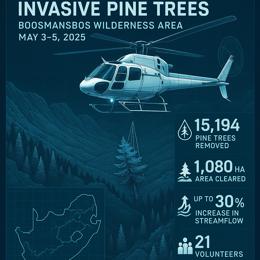Content created by AI
Constantiaberg Area On Alert: Chrysalis Academy Blaze Subdued, Invasive Species Fuel Fire Risk
Last night's precarious fire that ignited on the grounds of Chrysalis Academy in Cape Town has been brought under effective control, thanks to the collaborative efforts of the City of Cape Town fire crews, NCC Wildfires, Volunteer Wildfire Services, and SANParks – Table Mountain National Park. Despite the containment, the potential for flare-ups endures as invasive plants and strong winds challenge fire management efforts.
The fire, intensified by the notorious Cape south-easterly winds, had rampaged northward towards the iconic mountain range. As the sun rose this morning, firefighters and support teams were still engaged in meticulous mop-up operations to prevent any resurgence, dealing with the residual hotspots on the charred landscape.
Officials are particularly propositioned on high alert due to the proliferation of non-native Australian tree species, primarily dense stands of Eucalyptus, Acacia, and other flammable invasives on the adjacent Porter Estate. These invasive species are a legacy of past forestry and landscaping practices, and their propensity to burn intensely increases the severity of wildfires.
These concerns are cast into sharper relief given the recovery of Constantiaberg's slopes post the significant fires of 2015. The exit from conventional plantation forestry has resulted in an unwelcome abundance of invasive plants and slash—the woody debris remaining from ongoing but incomplete clearance efforts. Experts estimate that this unmanaged biomass, amounting to 'hundreds of tons', significantly elevates the fire risk, creating a veritable tinderbox at the interface of urban development and natural vegetation.
While controlled burns and fuel removal attempts have been undertaken, these have been insufficient in substantially reducing the combustible materials. As the winds continue to wield their unpredictable influence, the latent fire hazard indisputably remains a source of consternation for both authorities and residents.
Community cooperation is essential in this time of heightened risk. A plea for public awareness has been issued, urging citizens to keep a lookout for any sign of smoke and to swiftly communicate any fire observations to the City’s Emergency Call Centre. Through collective vigilance, Cape Town can better safeguard against the vicious cycle of wildfires exacerbated by a combustible mix of invasive vegetation and climatic elements.
The prevention and management of invasive species, particularly in fire-prone areas, is an issue of critical environmental significance. Invasive plants not only facilitate the spread of fires but also threaten biodiversity and water security—a pressing concern for a region still grappling with the impacts of recent droughts.
The current situation underscores the need for proactive, sustained measures in managing and mitigating fire risks associated with invasive species. This needs a strategic approach encompassing not just reactive firefighting but also preventive vegetation management. The combined efforts of government agencies, conservation bodies, and the community can contribute to enhancing the resilience of Cape Town’s natural and urban landscapes in the face of escalating wildfire threats.










